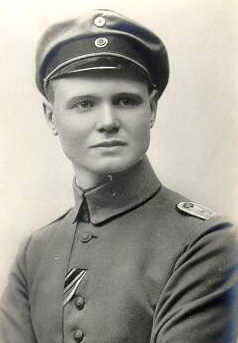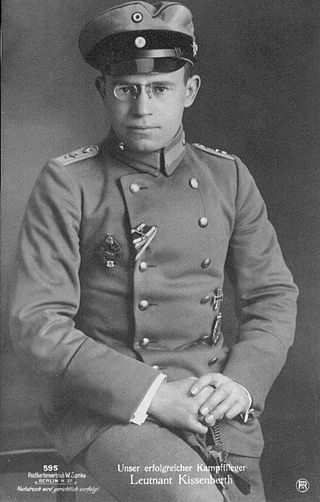Related Research Articles

Georges Guynemer was the second highest-scoring French fighter ace with 54 victories during World War I, and a French national hero at the time of his death. Guynemer's death was a profound shock to France.

The Deutsche Luftstreitkräfte —known before October 1916 as Die Fliegertruppen des deutschen Kaiserreiches —was the air arm of the Imperial German Army. In English-language sources it is usually referred to as the Imperial German Air Service, although that is not a literal translation of either name. German naval aviators of the Marine-Fliegerabteilung were an integral part of the Imperial German Navy. Both military branches operated aeroplanes, observation balloons and airships.

Karl Emil Schäfer was a German pilot during World War I; he became one of the major German flying aces of the war, with 30 confirmed aerial victories.

Otto Kissenberth was a German flying ace of World War I credited with 20 aerial victories. He was a prewar mechanical engineer who joined the German air service in 1914. After being trained and after serving as a reconnaissance pilot, he became one of the first German fighter pilots, flying with Kampfeinsitzerkommando KEK Einsisheim. He scored six victories with this unit as it morphed into a fighter squadron, Jagdstaffel 16. His success brought him command of Jagdstaffel 23 on 4 August 1917. He would run his victory tally to 20, downing his final victim using a captured British Sopwith Camel on 20 May 1918. Nine days later, a crash while flying the Camel ended Kissenberth's combat career. His injuries were severe enough he was not returned to combat, instead being assigned to command Schleissheim's flying school. Although Otto Kissenberth survived the war, he died soon after in a mountaineering accident on 2 August 1919.

Walter Blume was a German fighter ace of World War I. During World War I, he flew with two fighter squadrons, Jagdstaffel 26 and Jagdstaffel 9 gaining 28 aerial victories and earning the Iron Cross, Royal House Order of Hohenzollern, and the Pour le Merite.

Leutnant Otto Paul Wilhelm Höhne was a German World War I flying ace credited with six confirmed aerial victories. Höhne was a pioneer ace; he was the first pilot to score a victory while flying the Albatros D.1. During World War II he was a recipient of the Knight's Cross of the Iron Cross.
Adjutant Paul Armand Petit was a World War I flying ace credited with seven aerial victories, at least four of which were observation balloons.
Leutnant Ludwig Hanstein HOH, Bavaria's MMO was a World War I flying ace credited with 16 aerial victories.
LeutnantWilhelm Anton Seitz was a German World War I flying ace credited with 16 aerial victories. He scored those victories over a two-year span, beginning on 17 November 1916 and ending on 4 November 1918.
Offiziersstellvertreter Edmund Nathanael was a World War I flying ace credited with 15 aerial victories. He flew both two-seater reconnaissance aircraft and single-seater fighter craft. He scored all his victories while flying for Royal Prussian Jagdstaffel 5, and received a rare award of the House Order of Hohenzollern for his valor. He was killed in action while serving the German Empire.
LeutnantPaul Strähle was a German World War I flying ace credited with 15 aerial victories.

During World War I, the national air services involved developed their own methods of assessing and assigning credit for aerial victories.
Oberst Paul Aue was a World War I flying ace from the Kingdom of Saxony in the German Empire. Partial records of his early aviation career credit him with 10 aerial victories. He would join the nascent Luftwaffe during the 1930s and serve Germany through World War II. He died in a Russian prison camp in 1945.
Leutnant Adolf Schulte IC was a German World War I flying ace credited with nine aerial victories. His short gallant career would end in a fatal midair crash with his enemies.
Oberleutnant Walter Ewers was a World War I flying ace credited with eight aerial victories.
LeutnantHermann Habich (1895–?) was one of the original pilots in the Imperial German Air Service, having earned his brevet two months before World War I began. He is noted for having killed French aviation pioneer Roland Garros. Habich scored seven victories in all, becoming a flying ace. He joined the Luftwaffe in the 1930s and served in World War II.
References
- Norman Franks, Frank W. Bailey, Russell Guest. Above the Lines: The Aces and Fighter Units of the German Air Service, Naval Air Service and Flanders Marine Corps, 1914–1918. Grub Street, 1993. ISBN 0-948817-73-9, ISBN 978-0-948817-73-1.
- Jon Guttman. Bristol F2 Fighter Aces of World War I: Volume 79 of Aircraft of the Aces: Volume 79 of Osprey Aircraft of the Aces. Osprey Publishing, 2007.
ISBN 1846032016, 9781846032011.